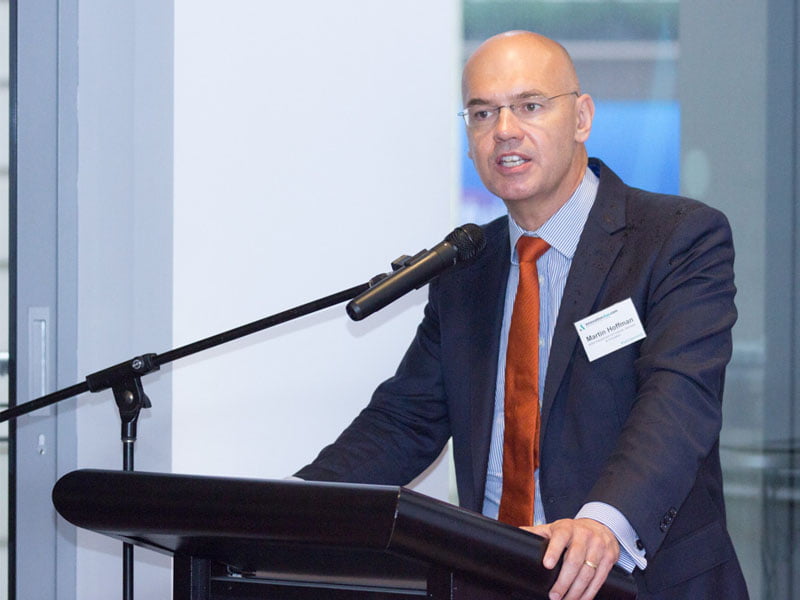The NSW Government has opened discussions with the Commonwealth to better exchange data between governments to improve digital service delivery, according to the recently-appointed secretary of the Department of Finance, Services and Innovation, Martin Hoffman.
The early stage talks include investigations of legislative and regulatory obstacles to more streamlined data interactions between businesses and citizens dealing with government.
Mr Hoffman, who was appointed to drive the NSW digital transformation agenda in July, was speaking at InnovationAus.com’s Open Opportunity Forum in Sydney last week.

NSW, which is more advanced than the Commonwealth in the development of its digital authentication and service delivery platforms, has previously made no secret of its view that it should be allowed to deliver Commonwealth services to NSW citizens through the NSW government’s infrastructure.
The new Prime Minister has similarly suggested that the Commonwealth could and should be able to facilitate state and local government services through its digital channels.
At issue are the myriad of laws and regulations around data sharing that would need to be tackled to enable this to take place (to say nothing of the political considerations.)
Mr Hoffman said NSW has already moved away from fixed-term panel contracts toward more flexible procurement models that were inclusive of smaller, more flexible suppliers, consolidated its data centres and re-forming them as “a marketplace for X-as-a-service”. And it has begun the process of building better data infrastructure to serve potential external providers.
“We have established the procurement innovation stream as part of the Procurement NSW organisation to provide a mechanism for small businesses to work with government on proof-of-concepts, and for startup contracts up to a ceiling of $250,000,” Mr Hoffman said, “and we have had some good take-up of that.”
He also pointed to work the department is doing around the collaborative economy.
There is a tender out right now to have a platform operator share the car spaces that government has in buildings across the city and to make them available on a time-share basis.
The consolidation of NSW government data centres to just two – one in Silverwater and one near Wollongong – is interesting, but more importantly they have been set up “as a digital community, a digital marketplace for as-a-service software suppliers, linked and federated to other clouds.”
The genuine challenge for government now, he says, is in dealing with the balancing of what he calls the “two-speed ICT system.”
On the one hand, there is all the excitement around digital services, apps and startups and all the issues that get talked about around the work of the Commonwealth’s Digital Transformation Office, and the work at ServiceNSW.
On the other hand, there are the glacial multi-hundred million dollar – or billion dollar – mega-systems-of-record, that can take years and years to complete.
“God built the world in seven days,” Mr Hoffman said, “but he didn’t have legacy systems to deal with.”
Better defining these projects and reducing the delivery times without compromising the integrity of the data is the great challenge for governments everywhere who are seeking to improve digital service delivery.
Ultimately it is these systems of record that will help drive government-as-a-platform initiatives.
Meanwhile, NSW is getting smart about the application of its data to improve delivery tasks.
The Government has appointed former CSIRO Digital Productivity & Services Flagship (now a part of Data61) director Ian Oppermann as interim Chief Data Scientist at its newly-established Data Analytics Centre.
The Premier Mike Baird has been given a real-time customer dashboard, where he can look up traffic congestion, wait-times in lines at ServiceNSW offices, as well public transport timetable issues from his desk.
Mr Hoffman says the dashboard – which was created by data scientists at NICTA – will most likely be made public as a real-time performance indicator for citizen services.
Currently about 40 per cent of customer interactions in NSW are driven through digital channels, with the rest done face-to-face (primarily through ServiceNSW physical outlets) or via call centres. Mr Baird wants that number to reach 70 per cent by 2019.
“We are ten points higher than we were a year ago,” Mr Hoffman said, “but as always the curve starts to flatten as you get to the higher numbers – so there is still a heap of work to do.
Do you know more? Contact James Riley via Email.

